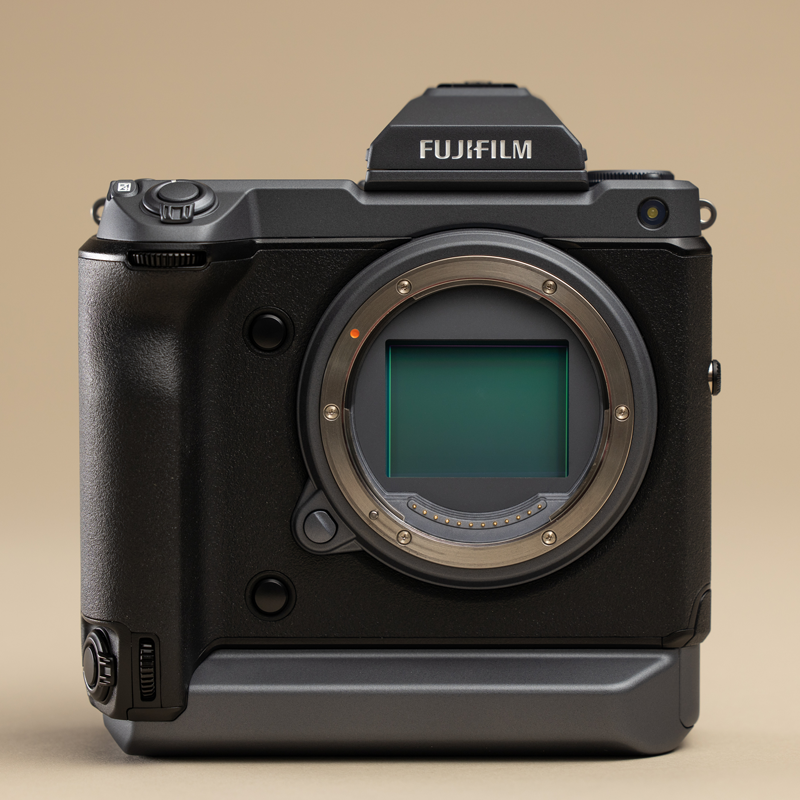Over the past 20 years, digital cameras have absolutely revolutionized the photo industry. The accessibility, prevalence, and relatively low cost of entry have exposed an unprecedented number of consumers to making photographs, whether it’s with a DSLR, mirrorless camera, or simply a cell phone. With more people than ever making photos, there are often questions about why you need certain features in your camera of choice, and here we’ll explore why you should consider stepping up to a medium format digital camera.
 The Fujifilm GFX 100 Medium Format Digital Camera
The Fujifilm GFX 100 Medium Format Digital Camera
Before we jump into the features and benefits of medium format, we need to understand how sensor formats are different from one another. Early DSLR manufacturers were technologically limited to sensors that were smaller than the 35mm negative size, which was the industry standard in the late 1990s. Nearly across the board, manufacturers had a 1.5x to 1.6x crop factor compared to 35mm film. This is where the term “crop frame sensor” comes from.
As technology improved and costs came down, manufacturers were able to offer sensors that were the same 24x36mm size as a negative, hence the term “full-frame sensor.” Medium format is larger still, and is analogous to medium film formats primarily used by commercial and high-end photographers. If you’ve not heard of 120 or 220 film, this is new information. Even if you have heard of it, you may be asking yourself why you need it. Here are five reasons to consider a medium format digital camera.
 Cropped Frame (Left), Medium Format (Middle), Full-Frame (Right)
Cropped Frame (Left), Medium Format (Middle), Full-Frame (Right)
1. Larger sensors allow for more resolution.
Just as with the full-frame digital cameras compared to crop frame, medium format sensors have more surface area, and can accommodate more resolution. At the time of this writing, 50MP of resolution is the entry point for a medium format sensor, with several options allowing 100MP, and there’s no reason to expect that this won’t continue to jump up significantly in the future. If you need plenty of resolution for cropping, capturing small details, or enlarging your prints to massive sizes, medium format continues to define the maximum available resolutions. But remember, not all pixels are created equal, which brings us to…
2. Because of the larger sensor, medium format cameras will have larger pixels.
If we compare a crop frame, full-frame, and medium format sensor, all with the same resolution, it makes perfect sense that the smaller sensors will have to shrink the pixel size to get them to fit into a smaller area. The larger pixels will capture more light, and the end result will be lower digital noise levels at higher ISOs. Translation: In low light, the medium format camera will outperform its smaller-framed competitors.
 High Noise vs. Low Noise
High Noise vs. Low Noise
3. The larger sensor also allows for wider dynamic range.
This is important as it allows you to preserve details that are often lost in the highlights and shadow areas of your image. Most full frame digital cameras provide 10-12 stops of dynamic range, while medium format can deliver up to 15 stops. Although editing software can recover much of this information in post-processing, details in deep shadows or extremely bright details can be lost forever without exposure bracketing and HDR processing. This is minimized with a medium format camera.
4. Medium format cameras will allow for greater control over your depth of field.
One of the biggest reasons commercial and professional photographers preferred medium format film was the superior way in which the falloff of focus of the larger formats was realized. This concept translates perfectly with the medium format digital cameras as well. If you’re looking for maximum creative control over your depth of field, medium format is where you need to be looking. This is often what people are trying to articulate when they talk about “the medium format look.”
5. Medium format cameras allow greater flexibility for creative format ratios.
Medium format cameras allow greater flexibility for creative format ratios. As with their film counterparts, medium format cameras have a variety of different aspect ratios that you can select without significant decreases in resolution or increases in processing needs. Cameras from Fuji and Hasselblad, for example, offer a 6x17 aspect ratio to allow for amazing panoramic images on a single shot, rather than the stitching and processing required for smaller-format systems. If you’re looking to shoot specific aspect ratios to maximize your creative vision, medium format gives you more options.
 Multiple Aspect Ratio Options
Multiple Aspect Ratio Options
Bonus feature - Bonus feature - Because of the modular nature of many medium format cameras, the digital backs are often removable and replaceable. This allows you to upgrade your sensor with newer technology as it becomes available or as your needs change. It also allows you to use the same camera for digital imaging or traditional film shooting. This obviously doesn’t apply to all medium format options, but is a bonus feature that is not available for smaller formats.
 Removeable Digital Backs of Medium Format Cameras
Removeable Digital Backs of Medium Format Cameras
As with the pre-digital days when film reigned supreme, medium format cameras continue to offer some significant advantages over their smaller format alternatives. If you are looking to separate yourself from the crowd with your digital imaging, remember that the larger “digital negative” will allow you to make larger and better images, and some or all of these advantages may be worth considering in an upgrade to medium format.

